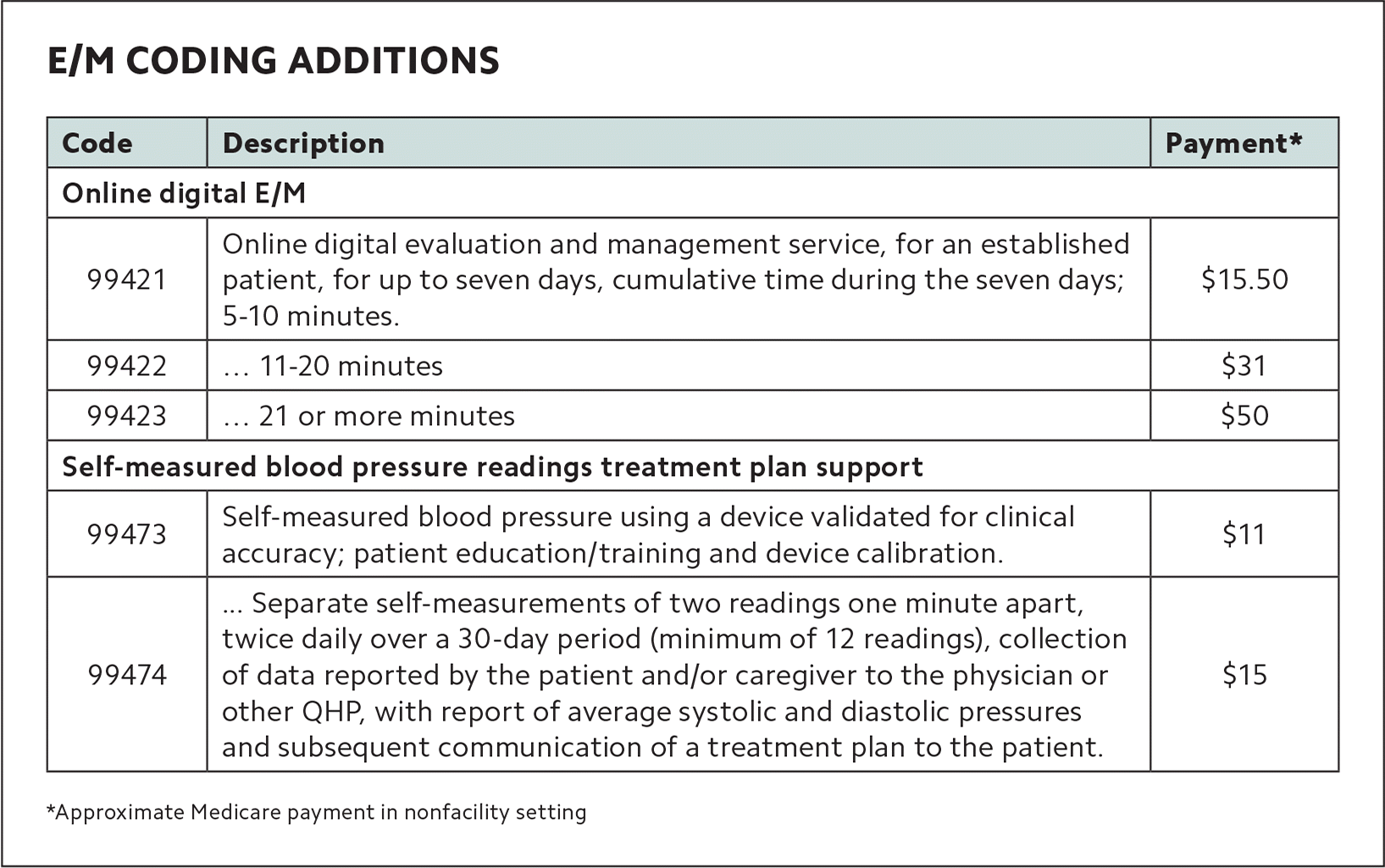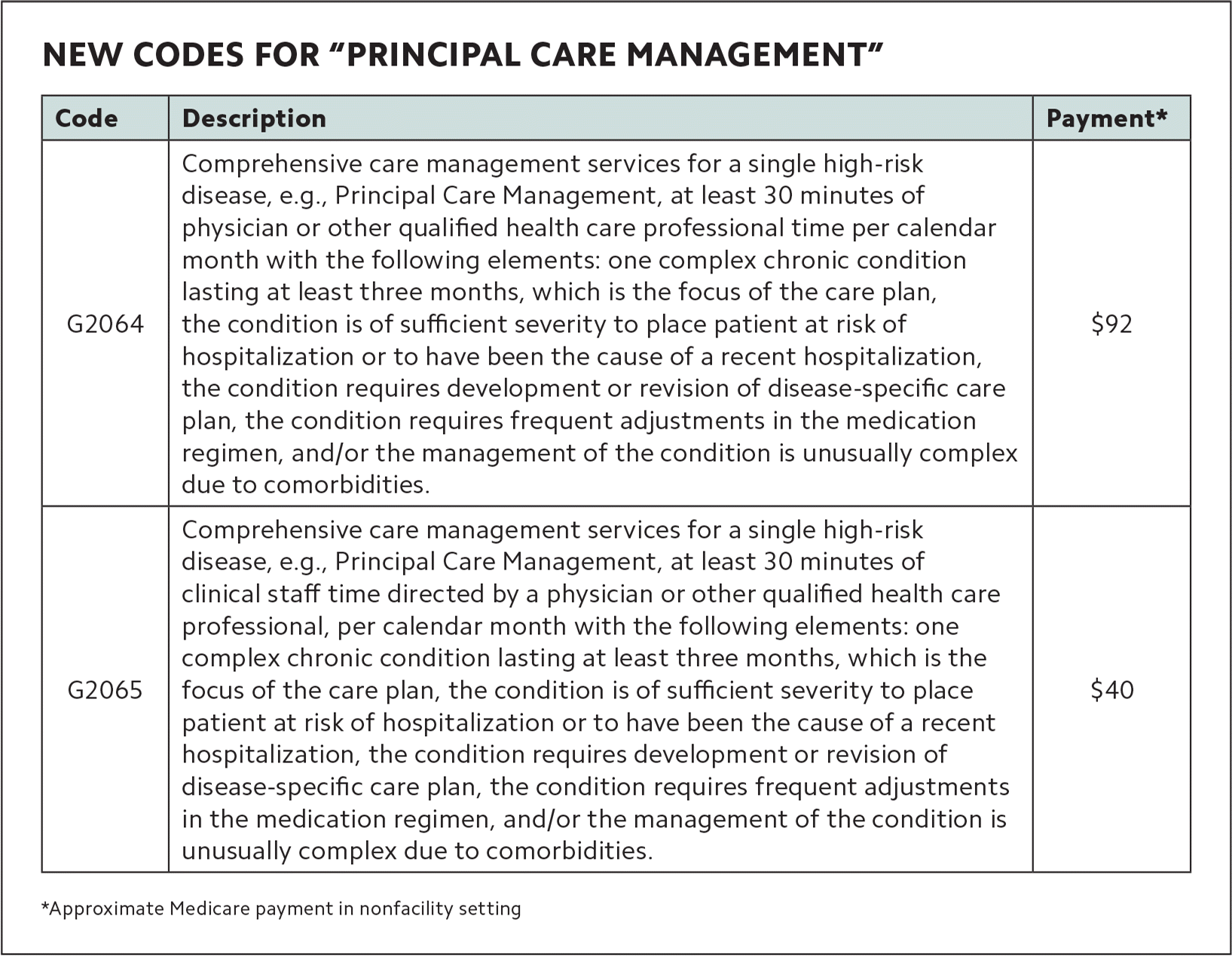
The Centers for Medicare & Medicaid Services is trying to make Medicare documentation less burdensome and planning more changes that should result in a pay raise for family physicians in the future.
Fam Pract Manag. 2020;27(1):8-13
Author disclosures: no relevant financial affiliations disclosed.

As usual, the new year brings changes in how doctors bill and get paid for the services they provide to Medicare patients. The reforms that will most affect family physicians’ pay aren’t coming until 2021, when several changes in evaluation and management (E/M) coding and payment are projected to result in a 12% increase for family medicine.1 But there are still a host of things family physicians should know for 2020, including new codes to help you get paid for interacting with patients via the internet and new codes that should help make chronic care management (CCM) more financially rewarding. The Centers for Medicare & Medicaid Services (CMS) is also continuing its quest to streamline documentation requirements and develop new payment models intended to reward quality instead of volume. This article summarizes the 2020 changes most relevant to family medicine. As always, private payers’ policies may differ, so consult with your billing staff to understand any important differences.
KEY POINTS
Evaluation and management (E/M) changes projected to raise family medicine payments by 12% are coming in 2021. The 2020 Medicare physician fee schedule update includes a variety of E/M and other changes that took effect Jan. 1.
There are new CPT codes for exchanging messages with patients through a secure online platform such as an electronic health record portal; developing and supporting blood pressure treatment plans in which patients measure readings themselves; and providing chronic care management services beyond the initial 20 minutes.
The list of services that can be reported concurrently with transitional care management has been expanded.
CURRENT PROCEDURAL TERMINOLOGY (CPT) CHANGES
This year’s CPT changes relate to some of the services family physicians provide most often.
Evaluation and management (E/M). Some of the biggest changes to E/M coding aren’t coming until 2021, when a revision of the office/outpatient visit codes will permit physicians to choose the level of service based on either medical decision making or time (not just face-to-face time) alone. Concurrent with those changes, CMS plans to increase the relative value of those services under the Medicare physician fee schedule and create an add-on code for visit complexity that can be used with most primary care visits. Look for more information on these changes in future issues of FPM.
For 2020, the office/outpatient visit E/M codes will remain the same. But there are other E/M changes in effect this year, including codes for exchanging messages with patients through a secure online platform, such as an electronic health record portal. CPT code 99444 has been deleted and replaced with codes 99421–99423, which allow time-based reporting of online digital E/M services provided by a physician or other qualified health care professional (QHP). Codes 99421–99423 are placed out of sequence in the CPT book, following code 99443 (see “E/M coding additions”).
E/M CODING ADDITIONS

| Code | Description | Payment* |
|---|---|---|
| Online digital E/M | ||
| 99421 | Online digital evaluation and management service, for an established patient, for up to seven days, cumulative time during the seven days; 5–10 minutes. | $15.50 |
| 99422 | … 11–20 minutes | $31 |
| 99423 | … 21 or more minutes | $50 |
| Self-measured blood pressure readings treatment plan support | ||
| 99473 | Self-measured blood pressure using a device validated for clinical accuracy; patient education/training and device calibration. | $11 |
| 99474 | ... Separate self-measurements of two readings one minute apart, twice daily over a 30-day period (minimum of 12 readings), collection of data reported by the patient and/or caregiver to the physician or other QHP, with report of average systolic and diastolic pressures and subsequent communication of a treatment plan to the patient. | $15 |
To bill for these services, the physician must be working with an established patient (though the problem may be new), the patient must be the one who initiates the services, and the problem must require a physician or QHP’s evaluation, assessment, and management.
Code selection should be based on the cumulative time that all physicians or QHPs in the same group practice devoted to the service in a seven-day period, including time spent addressing additional problems that emerged. Time spent by clinical staff who are not QHPs should not be counted. The seven-day period begins when the physician or QHP personally reviews the patient’s inquiry.
If any face-to-face E/M visit, including via telemedicine, is provided within seven days of the initiation of the online digital E/M service, the time or medical decision making of the online service should be added to that of the related face-to-face service and only the face-to-face service should be reported. Online digital E/M services may be reported separately within seven days of a face-to-face E/M visit if the patient requests the online services for a different problem than those addressed at the face-to-face visit. But you should not otherwise separately report online digital E/M services within seven days after a face-to-face E/M service or in the postoperative period of a procedural service.
Time attributed to online digital E/M services may not be used to support separately reported services such as collection and interpretation of physiologic data (99091), care plan oversight (99339–99340, 99374–99375, or 99377–99380), or chronic care management (99487, 99489, 99490, or 99491).
Note that online digital E/M is generally asynchronous communication, while there are other codes for telemedicine, which CPT defines as synchronous, real-time interaction with a patient. But as more patients seek remote access to care, knowledge and use of these new codes may provide more revenue for your practice to the extent your payers cover these services.
There are also new CPT codes for reporting services to develop and support blood pressure treatment plans in which patients measure readings themselves. Code 99473 pertains to calibrating the blood pressure device and training the patient to use it. Code 99474 pertains to the patient’s ongoing use of it, and data reporting.
Do not report 99473 or 99474 in the same calendar month as ambulatory blood pressure monitoring codes (93784–93790), which have been revised to describe current technology used for ambulatory blood pressure monitoring for 24 hours or longer but are otherwise unchanged. Also, do not report 99473 or 99474 with interpretation of physiologic data (99091), remote monitoring of physiologic parameters (99453, 99454, or 99457), or chronic care management (99487, 99489, 99490, or 99491). Code 99474 cannot be separately reported on a date when a face-to-face E/M service is provided by the same physician.
Lastly, add-on code 99458 has been created for reporting each additional 20 minutes spent in remote physiologic monitoring treatment management services. Code 99458 should only be reported with code 99457, which represents the first 20 minutes of remote physiologic monitoring in a calendar month.
Vaccines. Two new codes listed in CPT are preceded by a lightning bolt to indicate that the related vaccines are pending approval from the U.S. Food and Drug Administration (FDA). Code 90694 has been added for reporting a quadrivalent, inactivated, adjuvanted influenza virus vaccine that is preservative-free and delivered in a 0.5 mL dose by intramuscular injection. Code 90619 has been added for reporting a quadrivalent meningococcal conjugate vaccine that covers serogroups A, C, W, and Y and uses a tetanus toxoid carrier (MenACWY-TT).
Other services. Codes 96156, 96158–96159, 96164–96165, 96167–96168, and 96170–96171 replace codes 96150–96155 for health behavior assessments and interventions. Physicians and QHPs should still report E/M services in lieu of health behavior assessment and intervention codes when providing these services. However, new guidelines instruct that physicians and QHPs may report these services when provided by other health care professionals on the same date that the physician or QHP performs an E/M service.
CPT contains a set of supplemental tracking codes (Category II codes) that can be used for performance measurement. These Category II codes, distinguished by the letter “F” at the end of the code, are typically not payable. However, they facilitate reporting quality measures that may be important for pay for performance or other value-based payment arrangements.
Among them, codes 2022F, 2024F, and 2026F, used for reporting performance measures for diabetes mellitus, have been revised to indicate eye exams with evidence of retinopathy. New codes 2023F, 2025F, and 2033F are now used to report eye exams without evidence of retinopathy. For blood sugar measurement, code 3045F has been deleted and two new codes added for reporting most recent A1C ≥7% but <8% (3051F) or 8–9% (3052F). Check with the payers to whom you plan to submit these codes for their measure specifications.
HEALTHCARE COMMON PROCEDURE CODING SYSTEM (HCPCS) CHANGES
This year’s HCPCS changes increase the potential financial rewards of caring for patients with complex or recurring medical needs.
Chronic care management (CCM) services. CMS adopted a new HCPCS code specifically for Medicare, which will cover additional 20-minute periods of CCM beyond the initial 20 minutes. The new code, G2058, is an add-on code to 99490, which is used to report the initial 20 minutes. CMS will allow physicians to report G2058 up to twice per calendar month, to cover up to 60 minutes of clinical staff time spent in CCM. The new add-on code means that 99490 is no longer open-ended, and taking care of Medicare beneficiaries who require more time for CCM will potentially result in more revenue. CMS will allow approximately $38 for G2058 in a nonfacility setting, in addition to the approximately $42 it allows for 99490 in that setting.
CMS has also slightly modified its description of what a care plan typically includes. The agency eliminated the phrase “community/social services ordered, how the services of agencies and specialists unconnected to the practice will be directed/coordinated, identify the individuals responsible for each intervention” and inserted the phrase “interaction and coordination with outside resources and practitioners and providers.”
CMS also removed the requirement for substantial revision of the patient’s care plan when reporting CCM codes 99487 and 99489. CMS believes patients receiving CCM implicitly need and receive substantial care plan revision. This makes the service component of plan revision potentially duplicative with the medical decision-making service.
Principal care management (PCM) services. CMS is implementing coding and payment for PCM, which is care management for one serious chronic condition. CMS expects most of these services will be billed by specialists managing patients with a single chronic condition so complex that it cannot be managed as effectively in the primary care setting. But nothing prohibits primary care physicians from reporting PCM services when they provide them. If the patient only has one complex chronic condition overseen by the primary care physician, then the primary care physician would be able to bill for PCM services.
Also, the reporting of PCM by one physician (e.g., a specialist) does not prohibit the reporting of CCM by another (e.g., the primary care physician). But PCM cannot be billed by the same practitioner for the same patient concurrent with certain other care management services, such as CCM, behavioral health integration services, and monthly capitated end-stage renal disease (ESRD) payments. PCM is also not billable by the same practitioner for the same patient during a surgical global period.
Like CCM, PCM requires an initiating visit and documentation of the patient’s verbal consent in the medical record. Physicians and QHPs billing for PCM must also document ongoing communication and care coordination between all of the patient’s other physicians and QHPs.
For 2020, CMS will make separate payment for PCM via two new codes: G2064 for time spent by a physician or other QHP and G2065 for time spent by clinical staff under the direction of a physician or other QHP (see “New codes for ‘principal care management’”).
NEW CODES FOR “PRINCIPAL CARE MANAGEMENT”

| Code | Description | Payment* |
|---|---|---|
| G2064 | Comprehensive care management services for a single high-risk disease, e.g., Principal Care Management, at least 30 minutes of physician or other qualified health care professional time per calendar month with the following elements: one complex chronic condition lasting at least three months, which is the focus of the care plan, the condition is of sufficient severity to place patient at risk of hospitalization or to have been the cause of a recent hospitalization, the condition requires development or revision of disease-specific care plan, the condition requires frequent adjustments in the medication regimen, and/or the management of the condition is unusually complex due to comorbidities. | $92 |
| G2065 | Comprehensive care management services for a single high-risk disease, e.g., Principal Care Management, at least 30 minutes of clinical staff time directed by a physician or other qualified health care professional, per calendar month with the following elements: one complex chronic condition lasting at least three months, which is the focus of the care plan, the condition is of sufficient severity to place patient at risk of hospitalization or to have been the cause of a recent hospitalization, the condition requires development or revision of disease-specific care plan, the condition requires frequent adjustments in the medication regimen, and/or the management of the condition is unusually complex due to comorbidities. | $40 |
OTHER MEDICARE PHYSICIAN FEE SCHEDULE CHANGES
Other Medicare changes for 2020 include some much-requested attempts to ease documentation requirements and tweaks of new payment programs.
Review and verification of medical record documentation. Last year CMS made a number of changes to ease documentation requirements, especially for established patients. But onerous documentation continues to be an issue, and CMS is making more changes to relieve the burden this year. On Jan. 1, the agency began allowing physicians, physician assistants (PAs), or advanced practice registered nurses (APRNs) who furnish and bill for their professional services to review and verify, rather than redocument, information added to the medical record by physicians, residents, nurses, students, or other members of the medical team in all settings. This applies across all Medicare-covered services paid under the physician fee schedule.
This new guidance includes notes documenting the clinician’s presence and participation in the services. While it changes who may document services in the medical record — subject to review and verification by the furnishing and billing clinician — it does not modify the standards or scope of documentation needed to demonstrate medical necessity of services or appropriate recordkeeping.
Transitional care management (TCM) services. CMS expanded the services that can be reported concurrently with TCM. These include the following:
Prolonged services without direct patient contact (99358-99359),
Home and outpatient International Normalized Ratio (INR) monitoring (93792-93793),
ESRD services for patients 20 and older (90960-90962, 90966, or 90970),
Interpretation of physiological data (99091),
Complex and noncomplex CCM (99487 and 99489-99491),
Care plan oversight (G0181-G0182).
CMS is also increasing its payment allowances for TCM. In 2020, the nonfacility allowance for Medicare participating physicians (unadjusted geographically) is $187.67 for 99495 and $247.94 for 99496.
Quality Payment Program (QPP) changes. The new Medicare physician fee schedule rule also includes updates to the QPP, the incentive payment program enacted in 2015 with the passage of the Medicare Access and CHIP Reauthorization Act, or MACRA, to replace the sustainable growth rate method of determining updates to the fee schedule. The QPP includes two tracks: the Merit-based Incentive Payment System (MIPS) and the Advanced Alternative Payment Model (AAPM).
Unlike past years, CMS chose to keep many requirements of the program stable from 2019 to 2020. The agency is maintaining the scoring methodology for the QPP and did not make significant changes to the AAPM track. The MIPS performance category weightings (45% quality, 25% promoting interoperability, 15% cost, and 15% improvement activities) will not change this year, nor will the performance periods (12 months of data for quality and cost and 90 days for improvement activities and promoting interoperability).
There were, however, some changes to other parts of the MIPS track for performance year 2020, which corresponds to payment year 2022.
One notable change pertains to reporting for the quality category. CMS has increased the data completeness threshold for quality measures to 70%. This means practices must report on at least 70% of patients, regardless of payer, who qualify for the measure. However, practices reporting via Medicare Part B claims only need to report on 70% of Medicare Part B patients eligible for the measure.
CMS also made some adjustments to the improvement activities and cost categories. In prior years, only one clinician within a group had to perform an improvement activity for the entire group to receive credit. Beginning in 2020, at least 50% of the group’s clinicians must perform the same activity for a continuous 90-day period to receive credit. However, it does not need to be the same 90 days for all clinicians.
CMS updated the total per capita cost and Medicare Spending per Beneficiary measures. Updated measure specifications can be found on Medicare’s QPP website (qpp.cms.gov).
The MIPS performance threshold has increased from 30 points to 45 points. The exceptional performance threshold will increase from 75 points to 85 points. Those who score above or below the performance threshold will receive Medicare Part B payment adjustments on a sliding scale up to +/−9%. Those who score above the exceptional performance threshold will be eligible for an additional payment adjustment of up to 10%, paid on a sliding scale.
FOR MORE INFORMATION
These updates reflect a high-level list of the most important changes you may want to know as 2020 begins. For more information, check your 2020 CPT and HCPCS books, the CMS fact sheet on the physician fee schedule, and the CMS QPP Resource Library.
